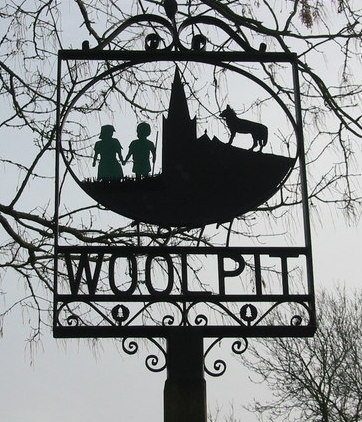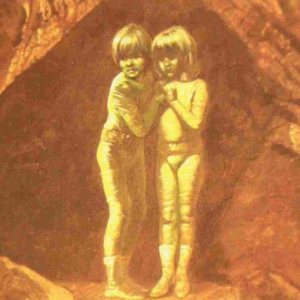
(Image: © alienelement)
In this world, people are of different skin colours varying from coal-black to snow-white. It is nothing interesting and is very usual to see people with those skin colours. But, it sounds mysterious to know about the two children, who supposedly appeared with an unusual skin colour in the village of Wool pit, England. These two children, who were well known as “The Green Children of Wool pit”, caught the attention of all the people living in the village in the 12th century, probably during the reign of King Stephen.
These two children, brother and sister, closely resembled the appearance of humans, except for the green colour of their skin. They spoke in an unknown language and would eat only raw broad beans. Their behaviour made the villagers perplexed and very curious to know about the place from which they had come. Two writers named Ralph and William reported on the sudden and mysterious arrival of the two green children during one summer.
ABOUT THE MYSTERY:
According to William, the villagers, while working on their fields, came across the frightening cries of these two children. They looked mysterious with green skin colour and a strange clothing. This led to the discovery of these two children. Ralph discloses that the children were taken to the home of Richard De Calne, who was an English squire and responsible for the villages in the East Anglia. For several days the pair refused to eat the food that was offered to them. One day when someone brought in some fresh bean stalks, they eagerly grabbed them and consumed. They gradually got adapted to the food there and lost their green colour as well in time. Unfortunately, the boy who seemed to be younger of the two became seriously sick and died soon after the both were baptised.
Eventually, the girl who was named “Agnes” had learnt to speak in the local language (English). She told that they had come from a land named “St Martin”, where the sun never shone and the people there, all green, lived in an enduring twilight. When she was asked about their arrival in the wool pit, she could only say that while she and her brother were herding their father’s cattle, they suddenly heard a loud noise and found themselves by the wool pit, where they were found by the villagers. She also described about the luminous land that could be seen across a river. An astronomer cum writer named Duncan Lunan has concluded that Agnes was married to a royal official, “Richard Barre”, based on his research into Richard’s family history.
Though Agnes lived long after her discovery, she could hardly give any information about their origin and their odd arrival in the wool pit. She was never able to help in further solving of the mystery.
VARIOUS EXPLANATIONS:
Many theories have been put forth regarding the happening that the two children were fairies, aliens from space, came from an underground world or from a parallel universe, had been held convict and persuaded as part of an elaborate jest, or were simply from a distant village with a different dialect of English and the green colour of their skin was due to some disease or because of malnutrition.

MOST PLAUSIBLE EXPLANATION:
Regarding the account of the strange land, Paul Harris proposed in Fortean Studies 4 that the children were Flemish orphans feasibly from a nearby place known as Fornham St. Martin, which was divided from Wool pit by the River Lark. A lot of Flemish immigrants had come during the 12th century but were tyrannized under the reign of King Henry II. If the children had run away to the Thetford forest, it might have seemed like permanent twilight to them. They may also have entered one of the many underground mine passages there, which finally led them to Wool pit. The strange Flemish clothes they wore and the language they spoke might be misunderstood by the villagers as speaking gibberish.
With regard to their green-hued skin, one explanation is that the children were suffering from chlorosis (Hypochromic Anemia). This condition is due to the malnutrition that affects the colour of red blood cells and results in a remarkably green shade of the skin. This theory could be well supported by the fact that the children were returned to the normal colour once they adapted to the food cuisine of the village where they were found and brought up.
A MYTH OF SIMILAR OCCURRENCE:
Another similar happening that first came into limelight with the book “Strange Destinies” by John Mackiln was “THE GREEN CHILDREN OF BANJOS” incident. In his book he reports that villagers in Banjos, Spain discovered the two children with a green skin colour and wearing a strange metallic cloth. Peculiarly, these two children were found in the same way just like the green children of Wool pit were found. There are more similarities and just a few differences between the two tales.
SIMILARITIES:
- The two children found were a boy and a girl.
- They were found by the villagers at the time of harvest.
- The colour of their skin was green, and they spoke an unknown language.
- They refused to eat anything except raw beans.
- They were returned to the normal colour once they adapted to the local diet.
- The boy sickened and died.
- The girl stated almost the same reason for their arrival.
DIFFERENCES:
- The place and the time they were found differ. The former children were found in Wool pit, England in the 12th century whereas the latter ones were found in a Spanish village named Banjos in the 19th century.
- The girl found in Banjos died after five years of her appearance whereas the girl found in Wool pit lived a long life and got married to a local man.

Whether true or not, many say that the green children of Banjos story was just a re-write of the incident of green children of Wool pit. The reason behind stating that the girl had died after five years in the latter case might be due to cause that researchers could ask for the evidences if Mackiln reports the girl to be alive. However, there are no evidences for this story to be true. There are possibilities that this story might be a false lead one.
The story of green children of Wool pit has lasted for over eight centuries since the first noted accounts. While some outlook the story as a folktale, others accept it as a real one. While the real facts behind the story may never be known, it has provided the inspiration for innumerable poems, operas, novels and plays across the world. Without a doubt it continues to capture the imagination of many curious minds.
By Penumalla Aditya Pavani, Kondukuduru, Andhra Pradesh


